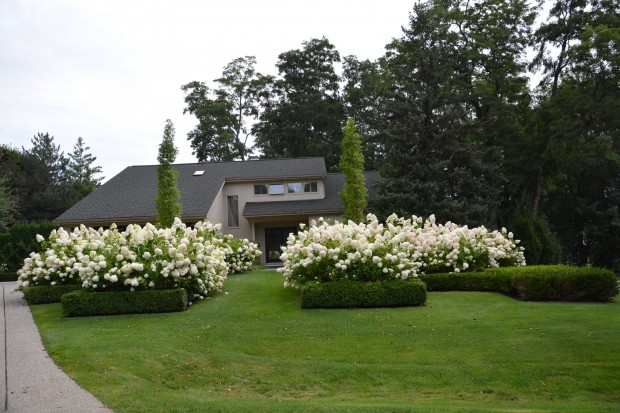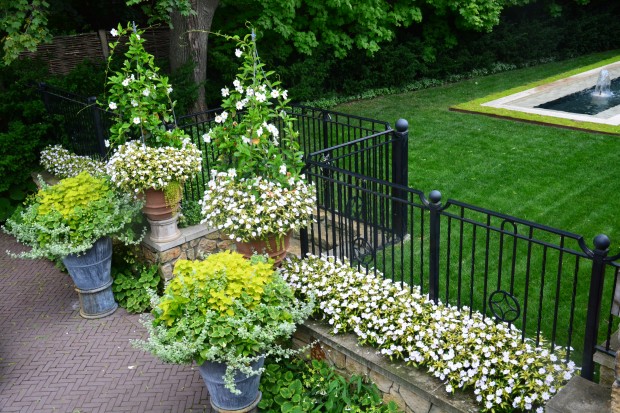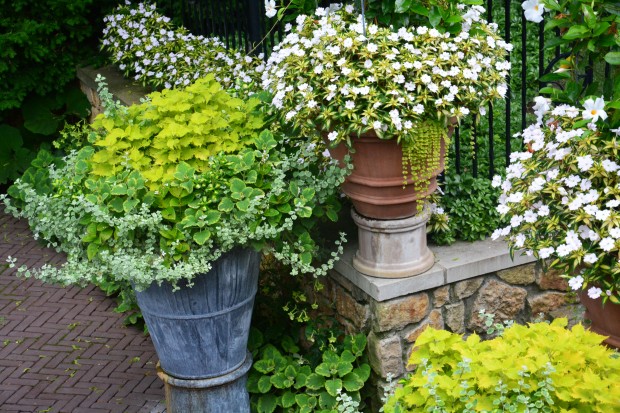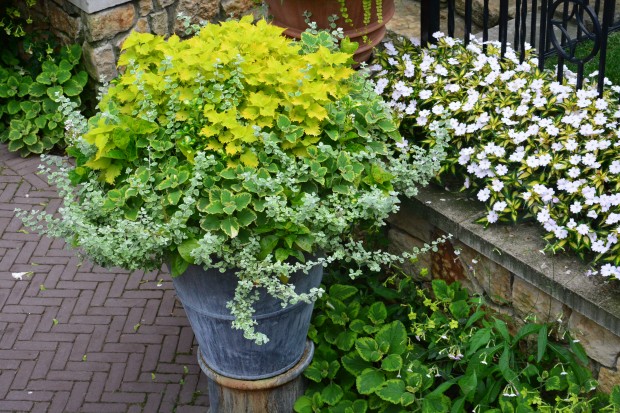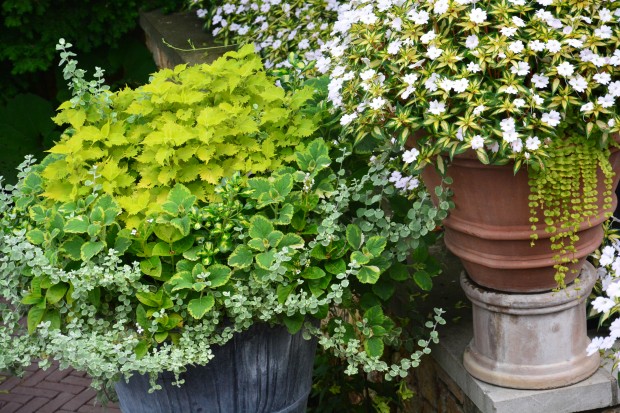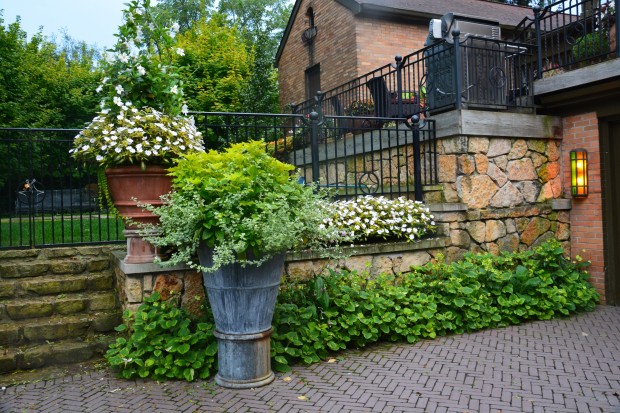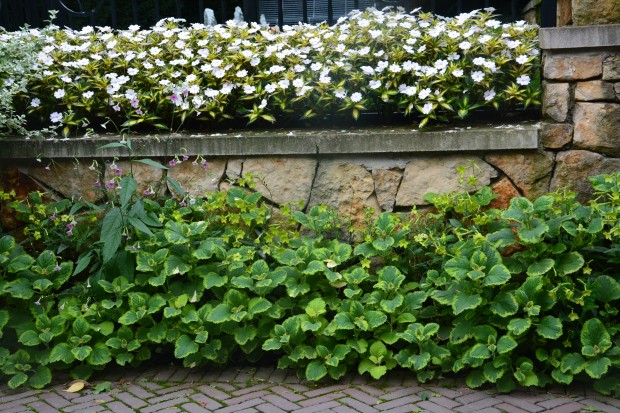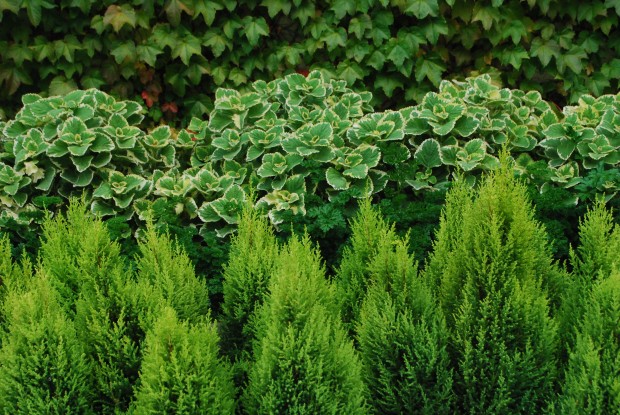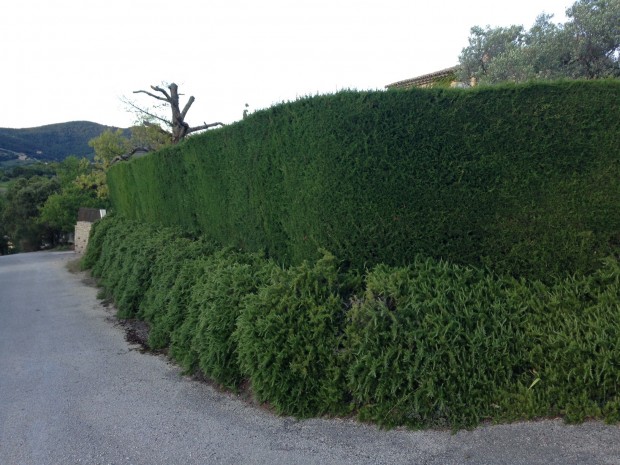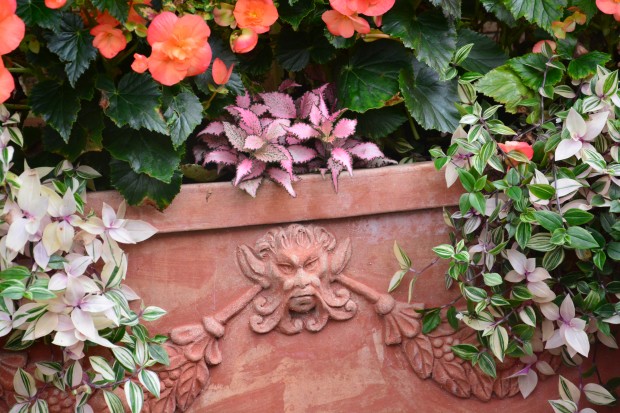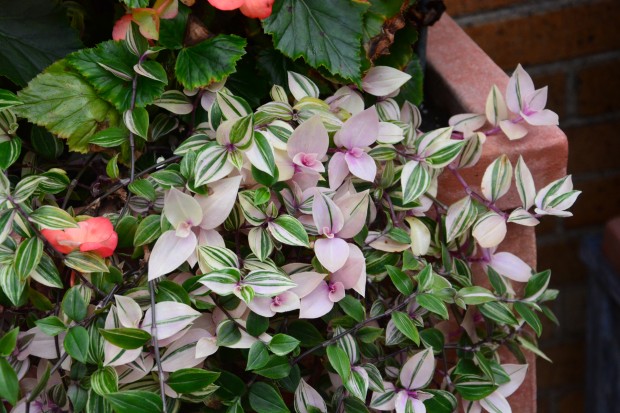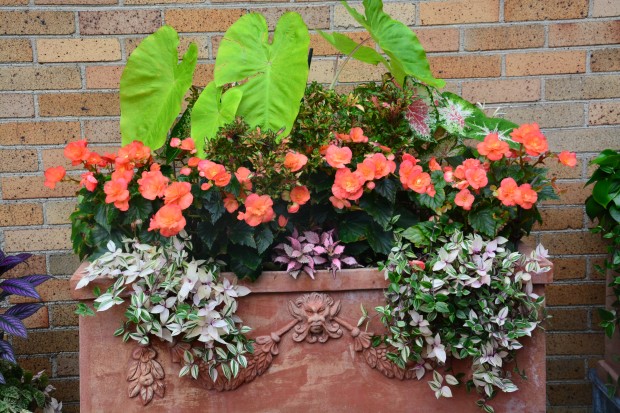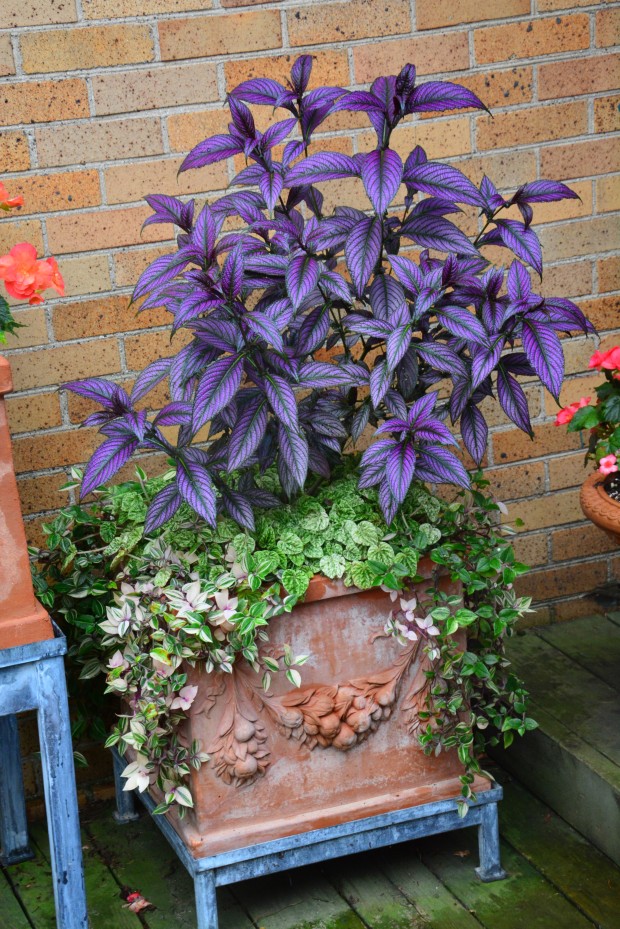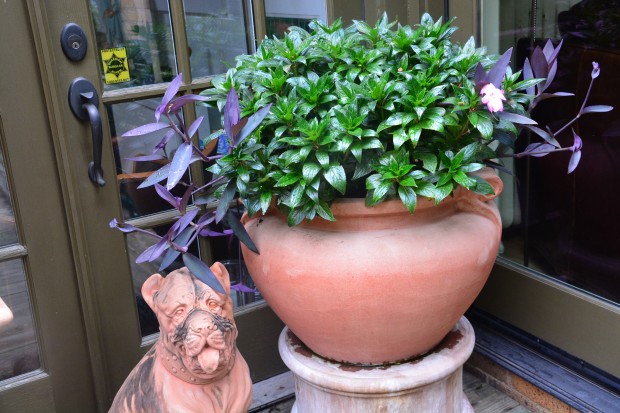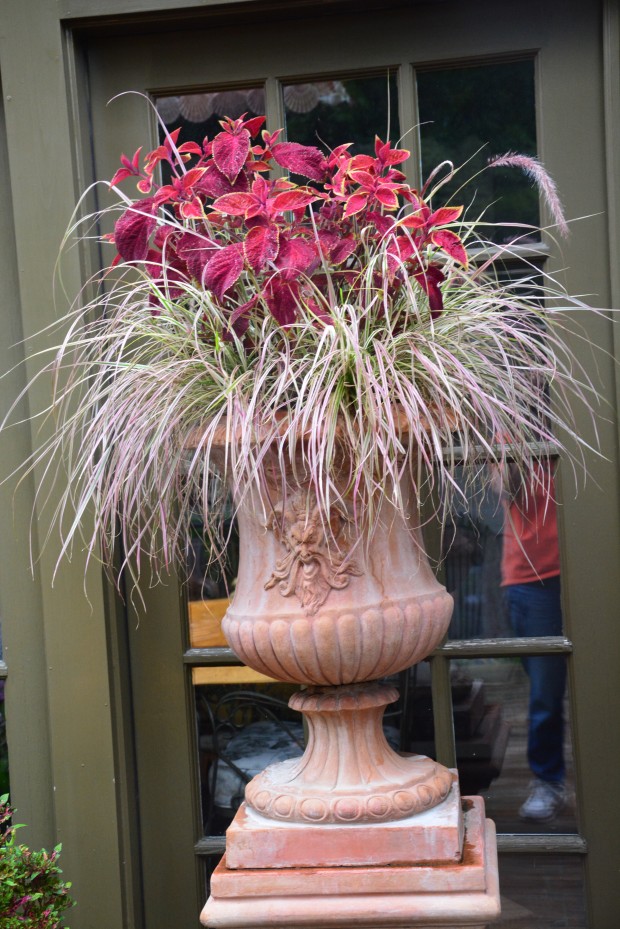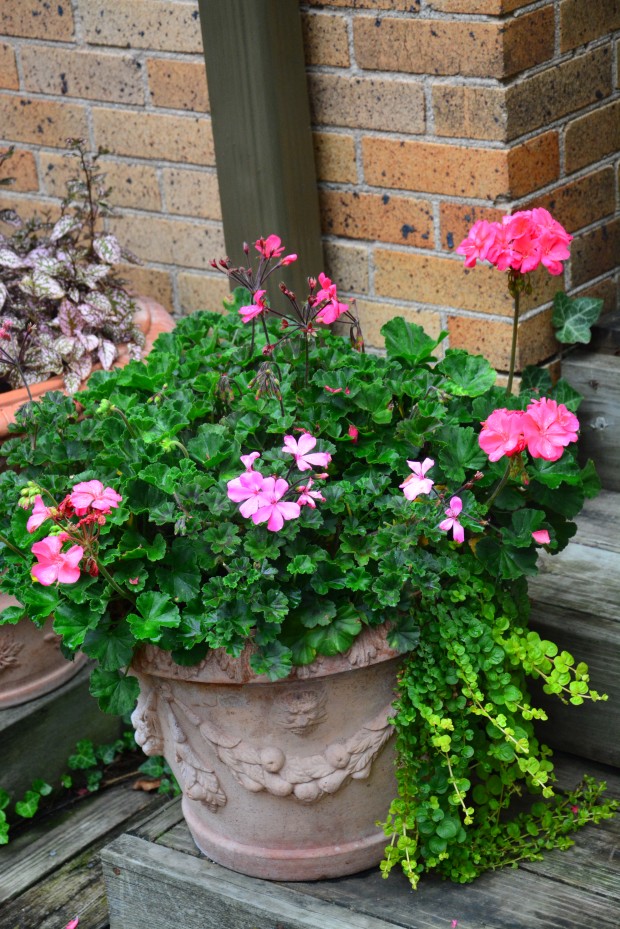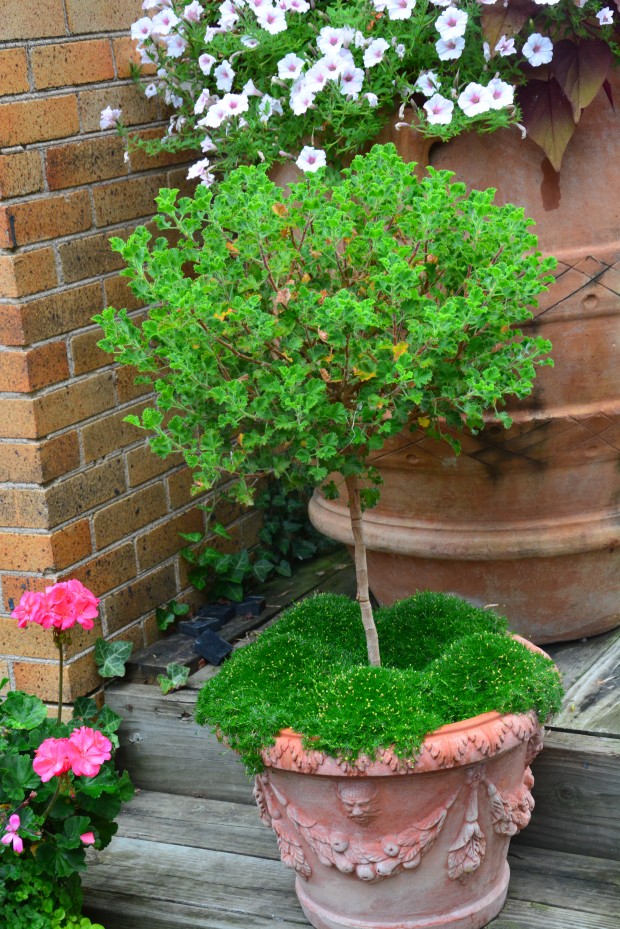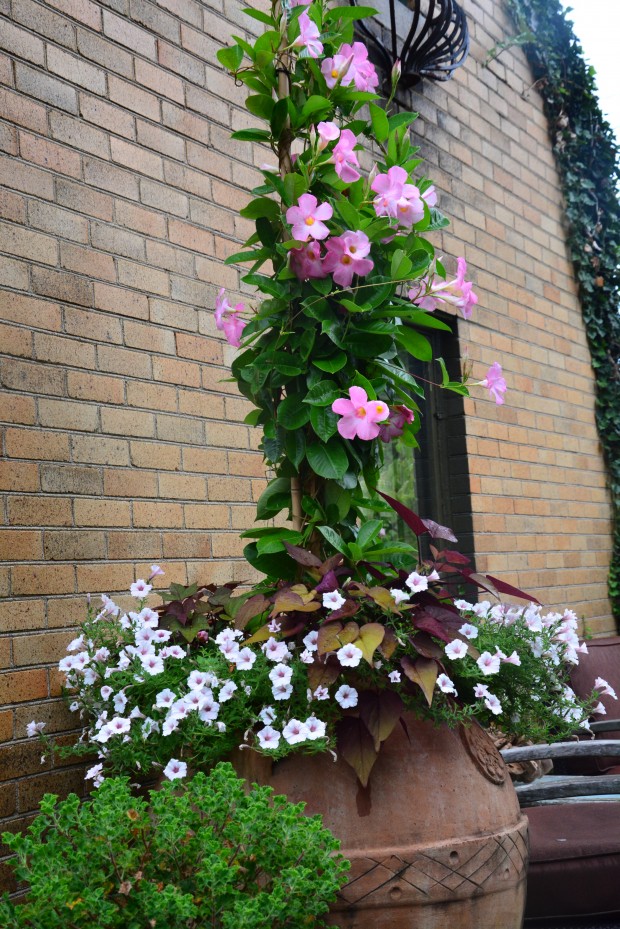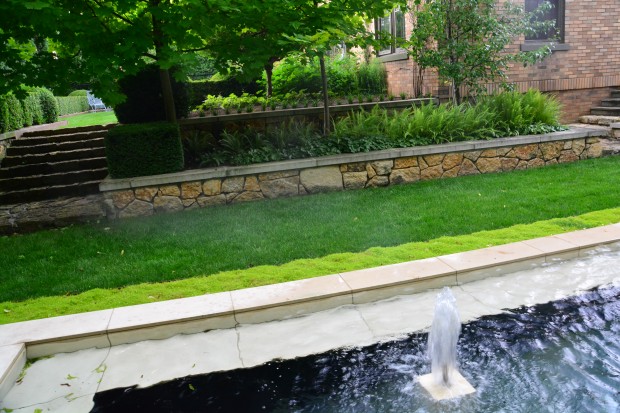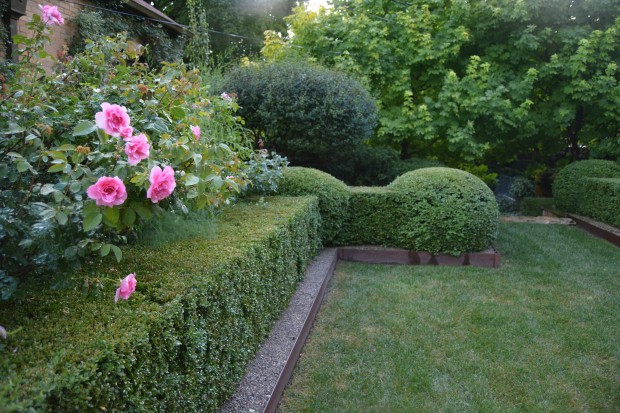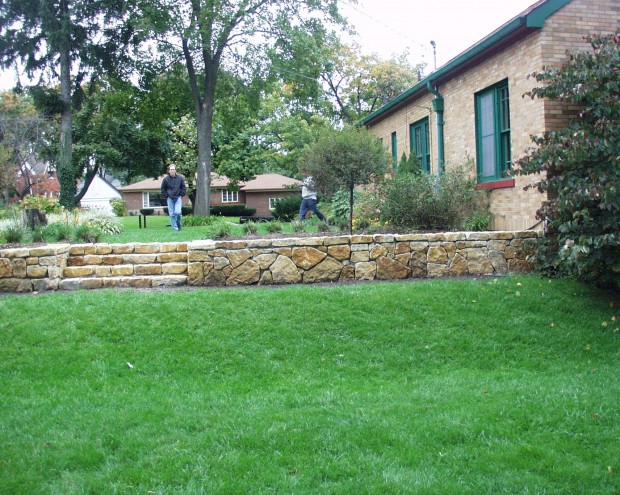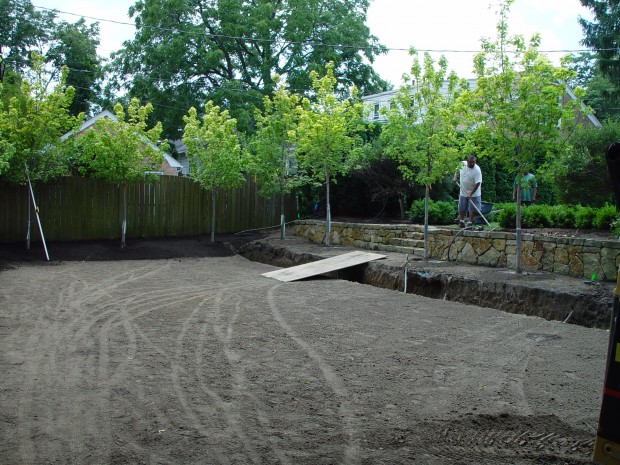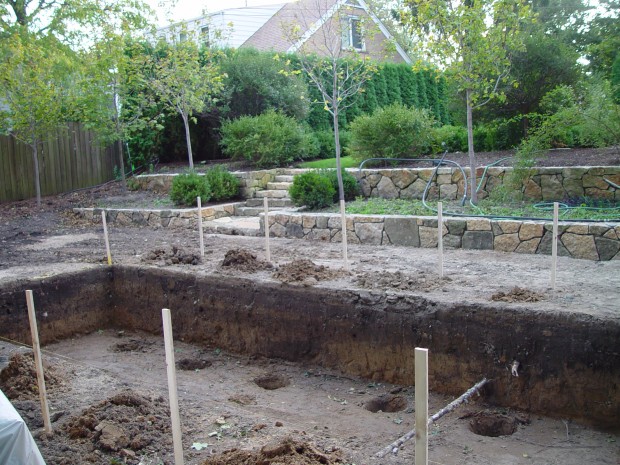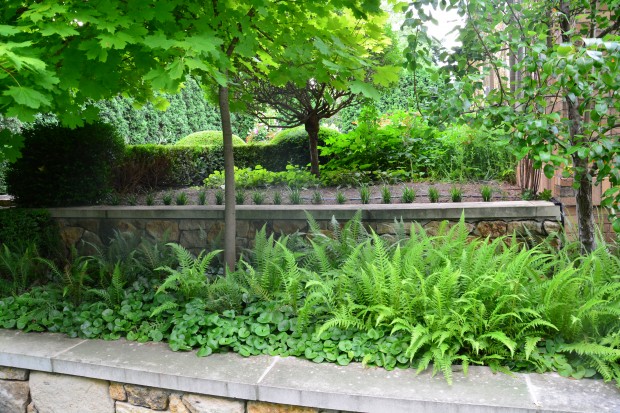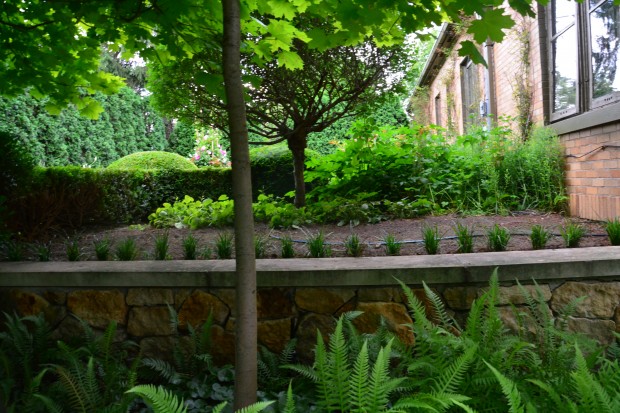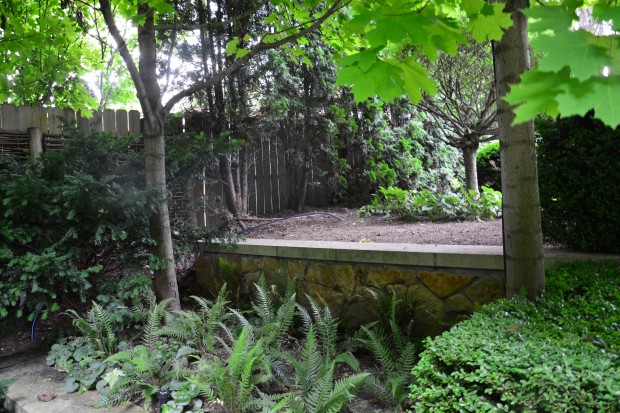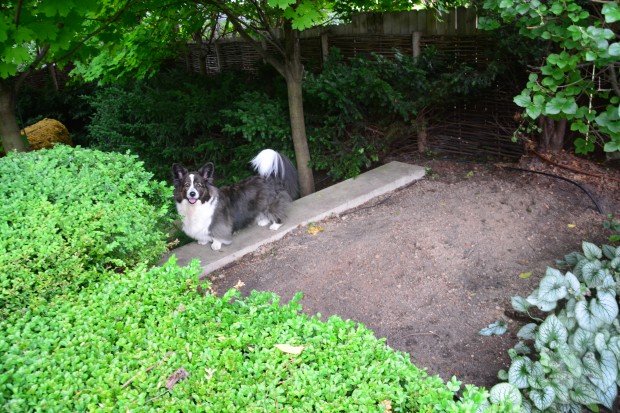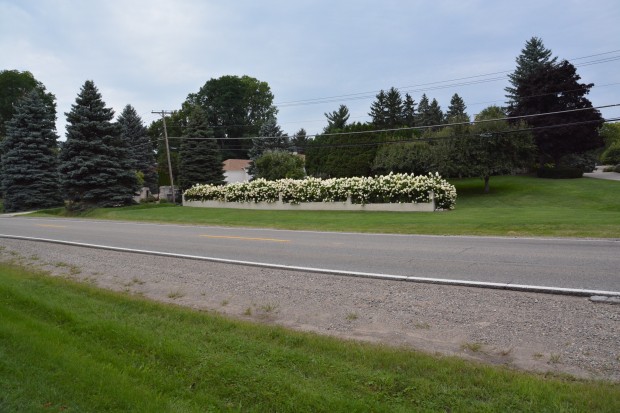 I know this is the mid westerner in me talking, but is there any shrub more widely hybridized and marketed and eventually disappointing than the hydrangea? I can barely keep up with the new cultivars. Some are blue. Some are blue and pink. Some are red. Some claim to bloom all summer. A list of of all the names would take better than a paragraph. All Summer Beauty, Nikko Blue, Endless Summer, Pinky Winky, Vanilla Strawberry, Invinciball – the list is long. The promises made for these new introductions are big. The performance of various cultivars of hydrangeas in the mid west-a mixed report. I drive by big plantings of hydrangeas every day that are all about the leaves with precious little in the way of flowers. Some are planted in much too much shade. But others just are not great bloomers. If you are a gardener in my area, and have a big love for hydrangeas that bloom reliably, consider the paniculata hybrids, especially the Lime lights.
I know this is the mid westerner in me talking, but is there any shrub more widely hybridized and marketed and eventually disappointing than the hydrangea? I can barely keep up with the new cultivars. Some are blue. Some are blue and pink. Some are red. Some claim to bloom all summer. A list of of all the names would take better than a paragraph. All Summer Beauty, Nikko Blue, Endless Summer, Pinky Winky, Vanilla Strawberry, Invinciball – the list is long. The promises made for these new introductions are big. The performance of various cultivars of hydrangeas in the mid west-a mixed report. I drive by big plantings of hydrangeas every day that are all about the leaves with precious little in the way of flowers. Some are planted in much too much shade. But others just are not great bloomers. If you are a gardener in my area, and have a big love for hydrangeas that bloom reliably, consider the paniculata hybrids, especially the Lime lights.
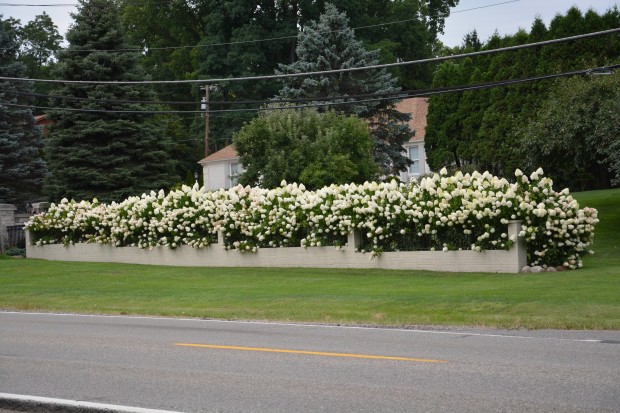 We did have a terrible winter-no gardener would dispute this. But the hydrangeas I see everywhere with one bloom or so is a usual thing. Some cultivars bloom on old wood. In a hard winter, the bloom shoots freeze. Though the plant may come back and thrive, there are little to no blooms. Some cultivars rely on more temperate zones than ours. Some cultivars seem to bloom with abandon for growers, but fail to deliver with gardeners. The Limelight hydrangeas pictured above are on a very busy street in my area, in full sun. They are blooming their hearts out. I have no idea what the gardener in charge does for these plants, but they are gorgeous. It could very well that this gardener leaves well enough alone. This brick wall would be lonely indeed without the hydrangeas.
We did have a terrible winter-no gardener would dispute this. But the hydrangeas I see everywhere with one bloom or so is a usual thing. Some cultivars bloom on old wood. In a hard winter, the bloom shoots freeze. Though the plant may come back and thrive, there are little to no blooms. Some cultivars rely on more temperate zones than ours. Some cultivars seem to bloom with abandon for growers, but fail to deliver with gardeners. The Limelight hydrangeas pictured above are on a very busy street in my area, in full sun. They are blooming their hearts out. I have no idea what the gardener in charge does for these plants, but they are gorgeous. It could very well that this gardener leaves well enough alone. This brick wall would be lonely indeed without the hydrangeas.
 I plant professionally, meaning plants that cannot or do not perform are discouraging. I hope that every landscape I design and install encourages my clients to become involved, take over, and become interested in gardening when I am finished. This means I favor plants that have some success features built in. I like plants that thrive. Hydrangeas in full bloom are breathtakingly beautiful. Hydrangeas are by nature lusty growing and just about fool proof, given a proper placement. If you are keen for the flowers, and lots of them, Limelight delivers.
I plant professionally, meaning plants that cannot or do not perform are discouraging. I hope that every landscape I design and install encourages my clients to become involved, take over, and become interested in gardening when I am finished. This means I favor plants that have some success features built in. I like plants that thrive. Hydrangeas in full bloom are breathtakingly beautiful. Hydrangeas are by nature lusty growing and just about fool proof, given a proper placement. If you are keen for the flowers, and lots of them, Limelight delivers.
I have read so many articles claiming that hydrangeas thrive in the shade. Hmm. The shrubs may tolerate part shade, but good blooming on hydrangeas in my area asks for a fair amount of sun. Do not plant hydrangeas in shade, if you have a love for their flowers. They like regular moisture – the leaves are large, and thin. Those leaves will crisp if the plant goes dry. I have my hydrangeas at home on a drip zone, so when they need a drink, I can provide it right to the roots. I do not recommend overhead watering except when it comes from the sky.
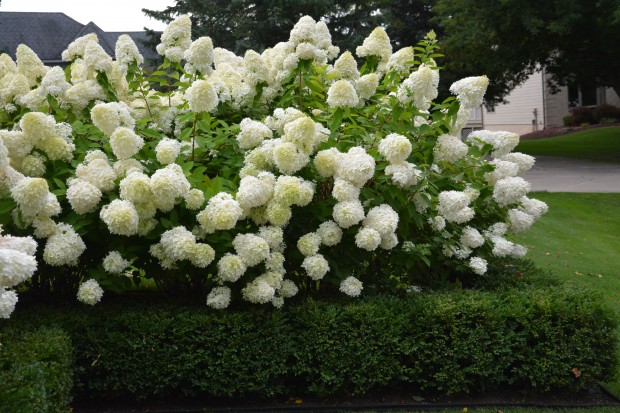 The old Annabelle hydrangea is as charming and as floppy as ever. They bloom early, usually in June. I like them placed on top of a wall, where their cascading habit looks graceful and deliberate. The Oakleaf hydrangea is just as beautiful in leaf as in flower – maybe more so. This bony structured, open growing hydrangea with its loosely arranged blooms-gorgeous. Climbing hydrangea does tolerate a lot of shade. It sits for a long time after planting. Once it gets going, it can engulf a wall.
The old Annabelle hydrangea is as charming and as floppy as ever. They bloom early, usually in June. I like them placed on top of a wall, where their cascading habit looks graceful and deliberate. The Oakleaf hydrangea is just as beautiful in leaf as in flower – maybe more so. This bony structured, open growing hydrangea with its loosely arranged blooms-gorgeous. Climbing hydrangea does tolerate a lot of shade. It sits for a long time after planting. Once it gets going, it can engulf a wall.
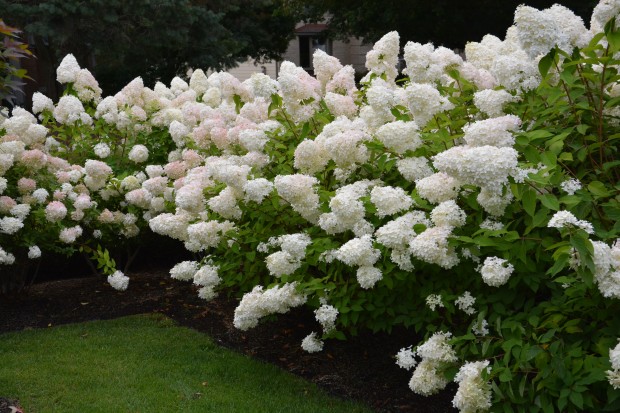 Pink and blue hydrangeas perform sporadically in my area. There are neighborhoods where they are lush and floriferous. I only have one client whose Nikko blue hydrangeas bloom heavily every year. They are grown in full sun, in a fairly protected location. The idea of using chemicals to alter the Ph of the soil is not my idea of gardening. Their is a hydrangea cultivar hydrangea macrophylla “Nantucket Blue”, for those gardeners with blue hydrangea envy. I have never grown it, but I have seen it for sale with the caveat “acidify the soil with sulfur for a deeper blue color”. There are those times when I am envious of what gardeners in other parts of the country are able to grow that I cannot, but that feeling is not that deep seated.
Pink and blue hydrangeas perform sporadically in my area. There are neighborhoods where they are lush and floriferous. I only have one client whose Nikko blue hydrangeas bloom heavily every year. They are grown in full sun, in a fairly protected location. The idea of using chemicals to alter the Ph of the soil is not my idea of gardening. Their is a hydrangea cultivar hydrangea macrophylla “Nantucket Blue”, for those gardeners with blue hydrangea envy. I have never grown it, but I have seen it for sale with the caveat “acidify the soil with sulfur for a deeper blue color”. There are those times when I am envious of what gardeners in other parts of the country are able to grow that I cannot, but that feeling is not that deep seated.
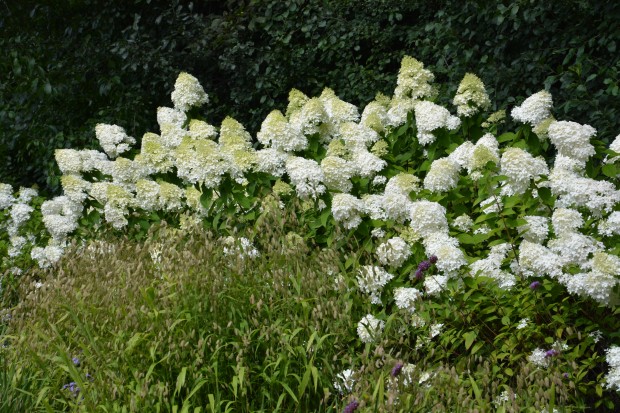 Lime lights are very big growing plants. Mine at home are over 8 feet tall this year. They have loved all of the rain. If your space is smaller, plant a smaller growing version. Little Lime tops out at 4-5 feet. Little Lamb is another smaller growing panicle hydrangea.
Lime lights are very big growing plants. Mine at home are over 8 feet tall this year. They have loved all of the rain. If your space is smaller, plant a smaller growing version. Little Lime tops out at 4-5 feet. Little Lamb is another smaller growing panicle hydrangea.
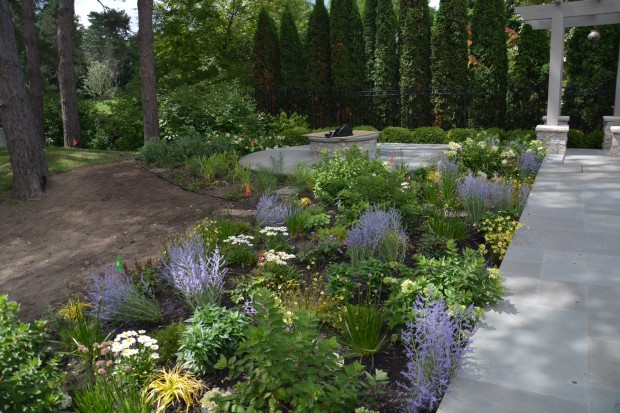 I am trying a new cultivar this year. “Bombshell’ is a dwarf cultivar that typically grows in a rounded mound to only 2-3′ tall and to 3-4′ wide. It was discovered growing in Boskoop, The Netherlands, in May of 2003 as a naturally occurring branch mutation on Hydrangea paniculata ‘Grandiflora’. It is particularly noted for its dwarf/compact shape, abundant star-shaped sterile flowers with elliptic sepals, dense nearly round flower panicles, and free blooming habit. It blooms earlier and longer than most other panicle hydrangeas.” – this description is from the Missouri Botanical Garden. I recently planted them with a collection of perennials that mature to about the same height. Big growing shrubs that are pruned to fit small space always have that uncomfortable and anxious feeling about them. A hydrangea planted with all the room it needs to grow is not only less maintenance, it looks good.
I am trying a new cultivar this year. “Bombshell’ is a dwarf cultivar that typically grows in a rounded mound to only 2-3′ tall and to 3-4′ wide. It was discovered growing in Boskoop, The Netherlands, in May of 2003 as a naturally occurring branch mutation on Hydrangea paniculata ‘Grandiflora’. It is particularly noted for its dwarf/compact shape, abundant star-shaped sterile flowers with elliptic sepals, dense nearly round flower panicles, and free blooming habit. It blooms earlier and longer than most other panicle hydrangeas.” – this description is from the Missouri Botanical Garden. I recently planted them with a collection of perennials that mature to about the same height. Big growing shrubs that are pruned to fit small space always have that uncomfortable and anxious feeling about them. A hydrangea planted with all the room it needs to grow is not only less maintenance, it looks good.
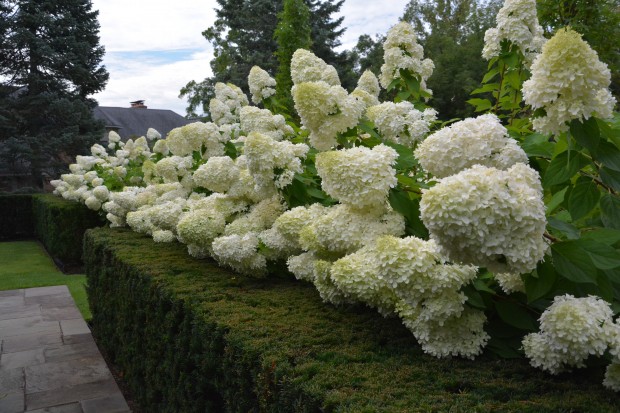 The Lime Lights are putting on a particularly good show this year.
The Lime Lights are putting on a particularly good show this year.
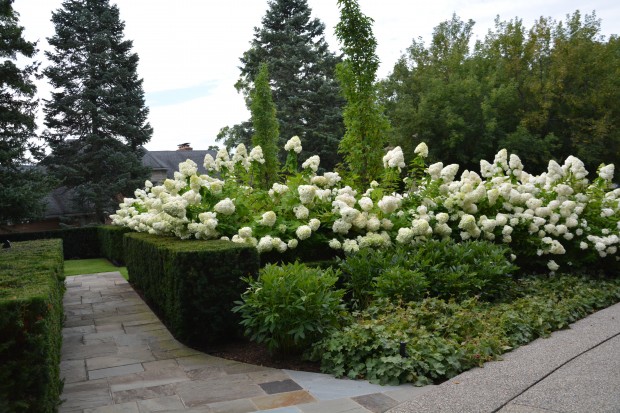 It wouldn’t be late summer in Michigan without them.
It wouldn’t be late summer in Michigan without them.
